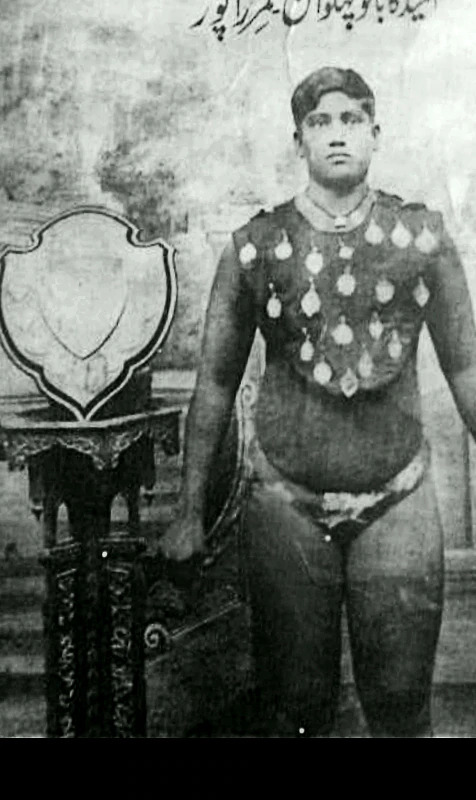The woman was five feet three inches tall. Of the 24 hours in the day, she spent nine sleeping, six training and the rest eating. She saw men not as contemporaries to be feared for their strength but as challenges to be conquered. She was Hamida Banu, a stalwart in the arena of Indian wrestling.
“Beat me in a bout and I’ll marry you.”
This was the challenge that male contemporaries who were to fight Hamida would hear before the wrestling match could commence. While some would laugh it off, wondering how this woman could beat them, stories of her success soon began to spread across Aligarh where she was settled to train.
Born in the early 1900s in Aligarh, she would carve a name for herself, that would go on to attract global acclaim. Hamida Banu was a woman unlike any other, and she’d not settle until the world saw it.
The legendary fight against the great Pahelwan

At a time when wrestling was considered to be a man’s sport and pride, Hamida entered the ring. With the pardah system in prevalence and women being expected to be dressed from head to toe, most men from the local community viewed Hamida in her sports attire with distaste. But she wasn’t one to confine herself to stereotypes and powered through, fighting against men, as women wrestlers in those times were unheard of.
The first wrestling match that truly got Hamida recognition was the face-off with Feroze Khan from Lahore in 1937 where she pinned him down, a surprise for Khan who was astonished that a woman could defeat him.
Following this feat, Hamida’s strength came to be well-known in Aligarh and throughout Uttar Pradesh. She defeated Khadag Singh, a Sikh and another wrestler from Kolkata. Both of these were challenged to defeat her to get her hand in marriage and they failed.
But of the many men she wrestled, the most unforgettable fight — that has been documented in the form of newspaper clips from that year — is said to be the one against Baba Pahelwan in 1954 at Baroda.
An interesting anecdote tells of how this wrestling match was almost a fated one. As it turns out, Chhote Gama Pahalwan, a wrestler who was patronised by the Maharajah of Baroda, was to be Hamida’s opponent.
The entire city had gathered to watch this match after hearing of Hamida’s widely told strength, but Gama withdrew from the fight at the last minute as he refused to fight a woman, leaving the next challenger Baba Pahelwan to fight Hamida.
The news article that was published the next day following the match carried the headline ‘Lady Wrestler Tosses Cupid Out of Ring for Third Time’. The reason for this interesting choice of words was the deal made between the two, with Hamida promising to marry the Pahelwan if he could beat her, while him swearing he’d retire if she beat him.
One minute and 34 seconds, and history was made as Baba Pahelwan had just clocked his last match.
237 pounds of indomitable spirit
An article in the BBC reported her daily diet — 5.6 litres of milk, 2.8 litres of soup, 1.8 litres of fruit juice, a fowl, nearly a kilo of mutton and almonds, half a kilo of butter, six eggs, two big loaves of bread, and two plates of biryani!
Hamida went on to win more than 320 matches across her career, but in spite of this, she had to go through a lot due to existing patriarchal norms. While she was forced to leave Punjab following physical assaults, she was stoned in Kolhapur when she defeated a male opponent. But she persisted, even going on to defeat international contemporaries including Vera Chistilin of Russia.
However, after a successful wrestling career, Hamida Banu appeared to almost vanish from the wrestling scene.
As the story goes, Hamida’s coach was Salam Pahalwan who would frequently travel with Banu for wrestling matches across India. His daughter Sahara said in an account that the two had gotten married — a claim that Feroz Shaikh (Hamida’s grandson, whose father Mr Shaikh was Hamida’s adopted son) denies.
Shaikh maintained that while Salam stayed with Hamida, the two were never married. Salam wasn’t too keen on Hamida travelling to Europe for matches and Shaikh recounted to the BBC, “To stop her [from going to Europe], he beat her with sticks, breaking her hands.”
It is said that Hamida Banu began selling milk and homemade snacks until her last days.
(Edited by Pranita Bhat)
Sources:
Hamida Banu: The incredible life of India’s ‘first’ woman wrestler, Published on 25 May 2022.
Uncovering the Legacy of Hamida Banu: The Fearless Female Wrestler of Colonial India by Paperclip.
If you found our stories insightful, informative, or even just enjoyable, we invite you to consider making a voluntary payment to support the work we do at The Better India. Your contribution helps us continue producing quality content that educates, inspires, and drives positive change.
Choose one of the payment options below for your contribution-
By paying for the stories you value, you directly contribute to sustaining our efforts focused on making a difference in the world. Together, let's ensure that impactful stories continue to be told and shared, enriching lives and communities alike.
Thank you for your support. Here are some frequently asked questions you might find helpful to know why you are contributing?

